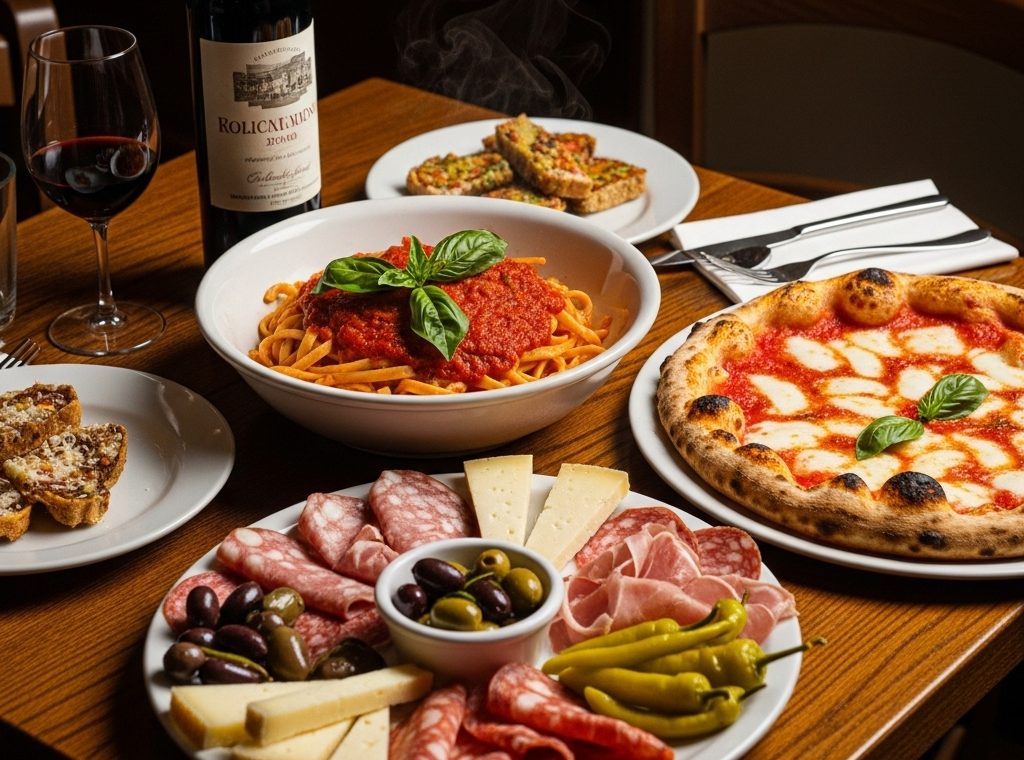Italian gastronomy is synonymous with tradition, art and passion. Each dish tells a story, each ingredient evokes a region and each bite transports you to the most beautiful landscapes of this country.
Italian cuisine stands out for its diversity, based on high quality products, simple but flavorful recipes and a deep respect for tradition. In this tour through the flavors of Italy, we will explore its fundamental ingredients, iconic dishes and sweet delicacies that have conquered the world.
Italian Gastronomy, The pillars of Italian cuisine
Italy is a country with an enormous gastronomic variety, where each region has its own specialties. However, there are elements that are common throughout the peninsula.
Key ingredients
- Extra virgin olive oil: Base of most of the preparations.
- San Marzano Tomatoes: Ideal for sauces due to their sweet flavor and low acidity.
- Quality flours: Indispensable for pasta, breads and pizzas.
- Cheeses and cured meats: They vary according to the region, from Parmigiano Reggiano to mozzarella di bufala.

Fundamental principles
- Simplicity with excellence: Priority is given to fresh and seasonal ingredients.
- Balance of flavors: No ingredient should overshadow the other.
- Traditional techniques: From the handmade paste to the maturing of the cheeses.
The most representative dishes of Italian Gastronomy
Neapolitan Pizza
Its spongy and thin dough, baked in a wood-fired oven, makes it a worldwide icon. The most classic versions include:
- Margherita: Tomato, mozzarella and basil.
- Marinara: Tomato, garlic, oregano and olive oil.

Pasta: the heart of Italian cuisine
Italy offers an immense variety of pasta, each with its own typical preparation:
- Carbonara (Rome): Made with guanciale, egg, pecorino and black pepper.
- Ragù alla Bolognese (Bologna): Slow cooked meat sauce served with tagliatelle.
- Pesto alla Genovese (Liguria): Basil sauce, garlic, pine nuts, cheese and olive oil.

Cheese and Charcuterie
Italy is a paradise for cheese and cold meat lovers:
- Parmigiano Reggiano: With its unmistakable umami flavor.
- Mozzarella di Bufala: Soft and creamy, ideal in salads and pizzas.
- Gorgonzola: An intense and creamy blue cheese.
- Prosciutto di Parma: Cured ham with a delicate flavor.
- Salame Milano: Fine texture and spicy flavor.
Traditional regional dishes
Each region has a unique culinary identity. Some examples include:
- Risotto alla Milanese (Lombardy): With saffron and parmesan cheese.
- Ossobuco (Lombardy): Veal shank stewed with white wine.
- Arancini (Sicily): Stuffed and fried rice balls.
- Focaccia (Liguria): spongy bread with olive oil.
The most delicious Italian desserts
Gelato: Creamier than regular ice cream, it comes in exquisite flavors such as pistachio and stracciatella.
Tiramisu: Layers of sponge cake soaked in coffee with mascarpone and cocoa.
Cannoli Siciliani: Crunchy tubes filled with sweet ricotta and decorated with pistachios or chocolate.
Panna Cotta: Creamy dessert accompanied by caramel or fruit coulis.
Sfogliatella: A sweet Neapolitan puff pastry filled with ricotta and semolina with a touch of orange.
Zabaglione: frothy cream of egg yolk, sugar and sweet wine.
Cassata Siciliana: Sponge cake with ricotta, candied fruits and marzipan.



The best Italian wines
Italy is a world leader in wine production, with internationally recognized appellations:
- Chianti (Tuscany): Excellent with meats and pasta.
- Barolo (Piedmont): Powerful and full-bodied, ideal for game dishes.
- Brunello di Montalcino (Tuscany): Sophisticated and complex.
- Amarone della Valpolicella (Veneto): Intense, perfect for aged cheeses.
- Prosecco (Veneto): Light sparkling wine, ideal for aperitifs.
- Lambrusco (Emilia-Romagna): Sparkling, fresh and fruity red wine.
- Marsala (Sicily): A fortified wine used in cooking and desserts.


Italian Cuisine in the World
The influence of Italian gastronomy is indisputable. Its dishes can be found in every corner of the planet, although the international versions often deviate from the original recipes.
True Italian flavors are based on the authenticity of ingredients and respect for tradition. To enjoy true Italian cuisine, it is essential to choose quality products and prepare recipes with care.
Conclusion: An unparalleled gastronomic heritage
Italian gastronomy is much more than a way of eating: it is a cultural legacy that unites generations. Every dish has a history, every recipe holds secrets handed down for centuries.
What is your favorite Italian food? Leave it in the comments and share this article with other Italian food lovers!
💛 With love, your Neapolitan girl.




